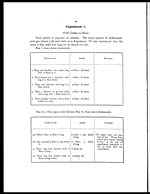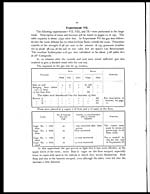Medicine - Institutions > Army health reports and medical documents > Scientific memoirs by officers of the Medical and Sanitary Departments of the Government of India > Number 38 - Preliminary report on the killing of rats and rat fleas by hydrocyanic acid gas > Preliminary report on the killing of rats and rat fleas by hydrocyanic acid gas
(29) Page 21
Download files
Individual page:
Thumbnail gallery: Grid view | List view

21
Experiment VI.
Does the gas kill cultures of micro-organisms and what effect has it on the
germinating power of grains? Does it render dry food-stuff poisonous?
The small room of 830 cubic feet capacity was used. About 4.38 cubic
feet of hydrocyanic acid gas was introduced by a fan and allowed to act 20
minutes from the start. The test rod showed plenty of gas to be present.
The grains tested were: (1) Bajri, (2), Wheat, (3) Jowari, (4) Mula or
Radish, and (5) Rice.
(1), (2), and (5) were put in kerosine oil tins. A pipe conveying the gas
was conducted to the bottom of the mass and one was directed on the surface.
Mula and jowari were in small amounts and gas played on their surface from
pipes directly placed on them.
I. Were the grains poisonous?
No. Tested on monkeys, rabbits, guinea-pigs, hens, and pigeons. Fed
on it for 24 hours. None dead nor ill. Again chapatis were made of the
wheat, jowari, and bajri, and monkeys and hens were fed on them. No ill
results.
II. The germinating power of the seeds was not affected. Certain quanti-
ties of the above grains were planted and seeds not subjected to the gas were
planted at the same time to serve as control in the comparison of the rate of
growth.
Both examples of bajri, jowari, and mula grew well; of wheat grew feebly,
because much of it was husked.
Cultures of (a) Micrococcus melitensis, (b) Cholera spirillum, and (c) Bacillus
anthracis, were placed in the room, but the cotton-wool stoppers were not removed
from the test-tubes containing the cultures as it was thought not to be safe to
do so. They were after subjection to the gas re-transplanted on agar and
showed good growths.
Test-tubes containing cultures of (a) Streptococci, (b) Bacillus typhosus,
(c) Bacillus coli communis, and (d) Bacillus pestis, were placed in the room
with their cotton-wool plugs removed, so that the gas had full action on the
germs. After the experiment the germs were recultured on agar. The Bacillus
pestis was overgrown with some yellow contaminating organism. The others
grew well and seemed to the naked eye to be pure cultures.
So probably the above germs are not affected by the gas.
Fleas after 5 minutes' exposure to the gas were found dead. They were
put into tubes and withdrawn after 5, 10, and 15 minutes' exposure, all dead.
[NLS note: a graphic appears here - see image of 75033636.tif]
Set display mode to: Large image | Zoom image | Transcription
Images and transcriptions on this page, including medium image downloads, may be used under the Creative Commons Attribution 4.0 International Licence unless otherwise stated. ![]()
| Permanent URL | https://digital.nls.uk/75033634 |
|---|
| Shelfmark | IP/QB.10 |
|---|---|
| Additional NLS resources: | |




